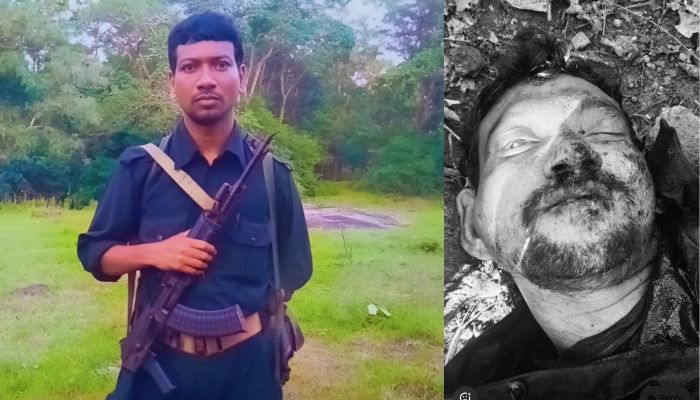Who was Madvi Hidma? India’s most-wanted Naxal commander behind 26 attacks finally killed in Andhra encounter
On 18th November, security forces eliminated India’s most-wanted Naxal commander Madvi Hidma in an encounter in the Maredumilli forests of Alluri Sitharama Raju district of Andhra Pradesh. The security forces conducted an operation between 6 am and 7 am near the Chhattisgarh border. Hidma’s wife Raje and senior cadres including Chelluri Narayana and Tech Shankar were also killed in the encounter. According to officials, a group of Naxals led by Hidma was trying to flee Chhattisgarh when they were intercepted. Top Maoist leader Hidma was killed in an encounter in the Maridmalli forest of East Godavari district, Andhra Pradesh. His wife, Raji (R.A.J.), was also killed in the exchange of fire along with four others. In total, six Maoists were gunned down. These are the latest pictures… pic.twitter.com/Y19ps8PTlW— Sudhakar Udumula (@sudhakarudumula) November 18, 2025 Hidma’s death is yet another decisive blow to the CPI (Maoist) in recent years. Home Minister Amit Shah has already stated several times that India will be free from Naxal extremism by March 2026. Notably, security agencies had set a deadline for Hidma’s capture by 30th November and he was eliminated just 12 days before. A career defined by terror across Bastar Hidma was a native of Purvathi in Sukma district of Chhattisgarh. He was one of the most feared and enigmatic Naxal commanders operating in the Dandakaranya region. Hidma was also known by aliases including Hidmalu and Santosh. He rose through the ranks over nearly two decades to become the head of the People’s Liberation Guerrilla Army (PLGA) Battalion No 1, considered the Naxals’ most lethal strike unit. Hidma was the youngest member of the CPI (Maoist) Central Committee and the only tribal from Bastar to reach that level. His rising influence earned him a cumulative bounty exceeding Rs 1 crore from central and state agencies. Who was Madvi Hidma? Hidma was born in 1981 in Purvathi village of Sukma district. He belonged to a poverty-stricken tribal community in south Bastar. As he rose through the ranks, Hidma became one of the most dreaded Naxal commanders in the country. In the late 1990s, he joined CPI (M). He was only a teenager and began as a ground-level organiser. Soon, he became an expert in guerrilla warfare and ambush operations. While most of the top Naxal commanders chose to stay away from the fighting units, Hidma remained with such units and led ambushes himself most of the time. He gained the attention of the security agencies after the deadly 2010 Dantewada attack which marked him as the principal architect of Naxal violence in the region. Hidma carried bounties worth over Rs 1 crore. However, he remained invisible to intelligence agencies. Earlier this year, a photograph finally surfaced. He continuously moved across forest areas and relied on dense jungle cover to remain hidden with his inner security ring of loyal cadres. According to security agencies, Hidma was the central figure behind almost every major Naxal ambush in south Bastar. His involvement was confirmed in the 2010 Dantewada massacre that led to the deaths of 76 CRPF personnel, the 2013 Jhiram Valley attack that wiped out senior Congress leadership in Chhattisgarh, and the 2017 Sukma strike that left 26 CRPF personnel dead. Hidma was also behind the Sukma-Bijapur ambush of 2021 where 22 security personnel lost their lives. His battalion operated with sophisticated weapons and manoeuvred through the rugged and little-charted Abujhmad forest belt. He was also reportedly present at the site of the 2011 Tadmetla attack leading to the deaths of 75 CRPF personnel and assisted senior commander Papa Rao in planning the strike. Why Hidma remained untraceable for years According to the officials, Hidma had intimate understanding of the Abujhmad, Sukma and Bijapur forest corridors. Furthermore, his four-layered security ring made him nearly impossible to track. His unit was equipped with automatic rifles and was trained in guerrilla warfare. He consistently operated with extreme mobility, making him a headache for the security forces. His wife Raje was an active member of the same battalion and reportedly participated in several major attacks. Thanks to Operation Kagar, Hidma’s security shield and ability to move freely across forest cover weakened. Security agencies ran coordinated operations across Chhattisgarh, Telangana and Andhra Pradesh that forced him to go deeper into the forests where his movements were eventually intercepted. Speaking to the media, a senior Chhattisgarh Police officer said, “Hidma had acquired a heroic image among his cadres, and his elimination is a major step towards ending Naxal terror in the Bastar region.” The state of the insurgency According to Chhattisgarh Police IG Bastar P Sundarraj, the region witnessed decisive gains against the Naxal network. He said, “Left Wing Extremism has been a major security challenge for decades, but



On 18th November, security forces eliminated India’s most-wanted Naxal commander Madvi Hidma in an encounter in the Maredumilli forests of Alluri Sitharama Raju district of Andhra Pradesh. The security forces conducted an operation between 6 am and 7 am near the Chhattisgarh border. Hidma’s wife Raje and senior cadres including Chelluri Narayana and Tech Shankar were also killed in the encounter. According to officials, a group of Naxals led by Hidma was trying to flee Chhattisgarh when they were intercepted.
Top Maoist leader Hidma was killed in an encounter in the Maridmalli forest of East Godavari district, Andhra Pradesh. His wife, Raji (R.A.J.), was also killed in the exchange of fire along with four others. In total, six Maoists were gunned down. These are the latest pictures… pic.twitter.com/Y19ps8PTlW
— Sudhakar Udumula (@sudhakarudumula) November 18, 2025
Hidma’s death is yet another decisive blow to the CPI (Maoist) in recent years. Home Minister Amit Shah has already stated several times that India will be free from Naxal extremism by March 2026. Notably, security agencies had set a deadline for Hidma’s capture by 30th November and he was eliminated just 12 days before.
A career defined by terror across Bastar
Hidma was a native of Purvathi in Sukma district of Chhattisgarh. He was one of the most feared and enigmatic Naxal commanders operating in the Dandakaranya region. Hidma was also known by aliases including Hidmalu and Santosh. He rose through the ranks over nearly two decades to become the head of the People’s Liberation Guerrilla Army (PLGA) Battalion No 1, considered the Naxals’ most lethal strike unit.
Hidma was the youngest member of the CPI (Maoist) Central Committee and the only tribal from Bastar to reach that level. His rising influence earned him a cumulative bounty exceeding Rs 1 crore from central and state agencies.
Who was Madvi Hidma?
Hidma was born in 1981 in Purvathi village of Sukma district. He belonged to a poverty-stricken tribal community in south Bastar. As he rose through the ranks, Hidma became one of the most dreaded Naxal commanders in the country. In the late 1990s, he joined CPI (M). He was only a teenager and began as a ground-level organiser. Soon, he became an expert in guerrilla warfare and ambush operations.
While most of the top Naxal commanders chose to stay away from the fighting units, Hidma remained with such units and led ambushes himself most of the time. He gained the attention of the security agencies after the deadly 2010 Dantewada attack which marked him as the principal architect of Naxal violence in the region.
Hidma carried bounties worth over Rs 1 crore. However, he remained invisible to intelligence agencies. Earlier this year, a photograph finally surfaced. He continuously moved across forest areas and relied on dense jungle cover to remain hidden with his inner security ring of loyal cadres.
According to security agencies, Hidma was the central figure behind almost every major Naxal ambush in south Bastar. His involvement was confirmed in the 2010 Dantewada massacre that led to the deaths of 76 CRPF personnel, the 2013 Jhiram Valley attack that wiped out senior Congress leadership in Chhattisgarh, and the 2017 Sukma strike that left 26 CRPF personnel dead.
Hidma was also behind the Sukma-Bijapur ambush of 2021 where 22 security personnel lost their lives. His battalion operated with sophisticated weapons and manoeuvred through the rugged and little-charted Abujhmad forest belt.
He was also reportedly present at the site of the 2011 Tadmetla attack leading to the deaths of 75 CRPF personnel and assisted senior commander Papa Rao in planning the strike.
Why Hidma remained untraceable for years
According to the officials, Hidma had intimate understanding of the Abujhmad, Sukma and Bijapur forest corridors. Furthermore, his four-layered security ring made him nearly impossible to track. His unit was equipped with automatic rifles and was trained in guerrilla warfare. He consistently operated with extreme mobility, making him a headache for the security forces. His wife Raje was an active member of the same battalion and reportedly participated in several major attacks.
Thanks to Operation Kagar, Hidma’s security shield and ability to move freely across forest cover weakened. Security agencies ran coordinated operations across Chhattisgarh, Telangana and Andhra Pradesh that forced him to go deeper into the forests where his movements were eventually intercepted.
Speaking to the media, a senior Chhattisgarh Police officer said, “Hidma had acquired a heroic image among his cadres, and his elimination is a major step towards ending Naxal terror in the Bastar region.”
The state of the insurgency
According to Chhattisgarh Police IG Bastar P Sundarraj, the region witnessed decisive gains against the Naxal network. He said, “Left Wing Extremism has been a major security challenge for decades, but the past few years have been significant for security forces. In the last two seasons, over 450 Naxal bodies have been recovered, including those of top commanders like Basavaraju.”
He added that more than 300 cadres, including Central Committee and Divisional Committee members, have surrendered in recent months. Over 2,200 Naxals have joined the mainstream in the last 20 months.
Modi Government on path of ending Naxalism in India
According to reply received in response to an RTI filed by OpIndia, it was revealed that under the leadership of Prime Minister Narendra Modi, Left-Wing Extremism (LWE) has receded sharply across the “Red Corridor” over 11 years.
A reply to OpIndia’s RTI on Naxalism from the Left-Wing Extremism (LWE) Division of the Ministry of Home Affairs (MHA), Government of India, shows that Chhattisgarh recorded the highest LWE surrenders (6,153) and the highest LWE killings (1,129) among the ten tracked states from May 2014 to 30th September 2025.
The year 2016 registered the most surrenders (1,440), while 2025 (till 30th September) logged the most LWE killings (311), which indicates shrinking insurgent space and intensified, intelligence-led operations. Minister of Home Affairs Amit Shah has publicly set March 2026 as the target to end the Naxal problem under Operation Kagar.
OpIndia received data on 10 states that are West Bengal, Kerala, Chhattisgarh, Jharkhand, Andhra Pradesh, Bihar, Odisha, Telangana, Madhya Pradesh and Maharashtra. According to the data, a total of 8,751 Naxals have surrendered since May 2014 and 1,801 Naxals have been killed. A total of 548 security personnel have lost their lives during operations and 1,630 civilians have been killed during that period. Furthermore, security forces have recovered 5,277 arms from LWEs between May 2014 and 30th September 2025.
The figures align with the Centre’s policy shift to coordinate inter-state operations, development-led outreach and targeted rehabilitation, which reduced the conflict to limited pockets. In a recent statement, HM Shah mentioned that the Naxal movement has reduced to just three districts across the country.


































































